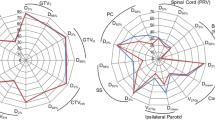Abstract
In intensity modulated radiation therapy (IMRT), the dose in each voxel of the organs at risk (OAR) can be strongly reduced compared to conformal radiation therapy (RT). Due to the sensitivity of late side-effects to fraction size, a smaller dose per fraction in the normal tissues represent an increased tolerance to RT. This expected reduction in biological effect may then be used as an additional degree of freedom during IMRT optimization. In this study, the comparison between plans optimized with and without a voxel-based fractionation correction was made. Four patients diagnosed with a head and neck (HN), a breast, a lung or a prostate tumor were used as test cases. Voxel-based fractionation corrections were incorporated into the optimization algorithm by converting the dose in each normal tissue voxel to EQD2 (equivalent dose delivered at 2 Gy per fraction). The maximum gain in the probability of tumor control (PB), due to the incorporation of the correction for fractionation in each voxel, was 1.3% with a 0.1% increase in the probability of complications (PI) for the HN tumor case. However, in plan optimization and evaluation, when tolerance doses were compared with the respective planned EQD2 (calculated from the 3-dimensional dose distribution), PB increased by 19.3% in the HN, 12.5% in the lung, 6.2% in the breast and 2.7% in the prostate tumor case, respectively. The corresponding increases in PI were 2.3%, 6.2%, 1.0% and 0.7%, respectively. Incorporating voxel-based fractionation corrections in plan optimization is important to be able to show the clinical quality of a given plan against established tolerance constraints. To properly compare different plans, their dose distributions should be converted to a common fractionation scheme (e.g. 2 Gy per fraction) for which the doses have been associated with clinical outcomes.
Access this chapter
Tax calculation will be finalised at checkout
Purchases are for personal use only
Similar content being viewed by others
References
Ferreira, B.C.; Lopes, M.C.; Mateus, J.; et al. Radiobiological evaluation of forward and inverse IMRT using different fractionations for head and neck tumours. Radiat Oncol. 5:57 (2010).
Emami, B.; Lyman, J.; Brown, A.; et al. Tolerance of normal tissue to therapeutic irradiation. Int J Radiat Oncol Biol Phys. 21:109–122 (1991).
Wyatt, R.M.; Beddoe A.H.; Dale R.G. The effects of delays in radiotherapy treatment on tumour control. Phys Med Biol. 48(2):139–55 (2003).
Partridge, M.; Ramos, M.; Sardaro, A.; Brada, M. Dose escalation for non-small cell lung cancer: analysis and modelling of published literature. Radiother Oncol. 99(1):6–11 (2011).
Pedicini, P.; Strigari, L.; Benassi M. Estimation of a self-consistent set of radiobiological parameters from hypofractionated versus standard radiation therapy of prostate cancer. Int J Radiat Oncol Biol Phys. 85(5):e231–7 (2013).
Fowler J.F. Optimum overall times II: extended Modelling for head and neck radiotherapy. Clinical Oncol. 20:113–126 (2008).
Källman, P.; Ågren, A.; Brahme, A. Tumour and normal tissue responses to fractionated non-uniform dose delivery. Int J Radiat Biol. 62(2):249–62 (1992).
Mavroidis, P.; Ferreira, B.C.; Papanikolaou, N.; Lopes, M.C. Analysis of fractionation correction methodologies for multiple phase treatment plans in radiation therapy. Med Phys. 40(3):031715 (2013).
Wieser, H.P.; Cisternas, E.; Wahl, N. et al. Development of the open-source dose calculation and optimization toolkit matRad. Med Phys. 44(6):2556–2568 (2017).
Author information
Authors and Affiliations
Corresponding author
Editor information
Editors and Affiliations
Ethics declarations
None.
Rights and permissions
Copyright information
© 2019 Springer Nature Singapore Pte Ltd.
About this paper
Cite this paper
da Costa Ferreira, B., Mavroidis, P., Dias, J., Rocha, H. (2019). Incorporating the Local Biological Effect of Dose Per Fraction in IMRT Inverse Optimization. In: Lhotska, L., Sukupova, L., Lacković, I., Ibbott, G. (eds) World Congress on Medical Physics and Biomedical Engineering 2018. IFMBE Proceedings, vol 68/3. Springer, Singapore. https://doi.org/10.1007/978-981-10-9023-3_74
Download citation
DOI: https://doi.org/10.1007/978-981-10-9023-3_74
Published:
Publisher Name: Springer, Singapore
Print ISBN: 978-981-10-9022-6
Online ISBN: 978-981-10-9023-3
eBook Packages: EngineeringEngineering (R0)




